To determine values, you can set single values or ranges of values.
- Detecting Fillets and Rounds by Setting Single Radius Values
- Detecting Fillets and Rounds by Specifying Ranges of Radius Values
This task also shows you how to delete colorization rules and provides useful notes about defining rules.
Open the GettingStarted.CATPart document.
-
Click the Part Analysis icon
 .
.
The Part Analysis dialog box appears.
It is divided into two areas: the left one is dedicated to rounds analysis, the right one to fillets analysis.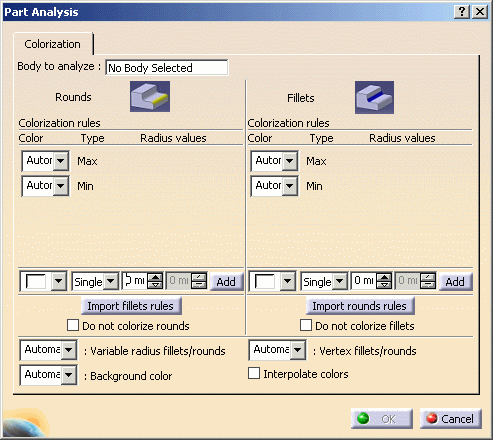
-
Select Body.1 as the body of which fillets and rounds you want to see. You can select it either by clicking on a node of the specification tree, or by selecting one of its face, edge or vertex in the geometry area. Note that only one body can be analyzed at a time.
Body.1 is now displayed in the Body to analyze field.Detecting Fillets and Rounds by Setting Single Radius Values
-
First, you are going to detect the number of rounds and fillets which radius value is 8mm in your part. For that, first you need to add colorization rules.
Rounds
-
At the bottom of the Colorization rules frame, there is a rule you can define and then add. For the single value rule, keep the rule type option as Single.
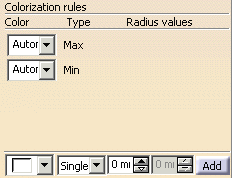
-
To the left of Single, click the color combo box.
A list appears containing:-
a blank color field
-
a list of default colors from the color palette, ready for use
-
the More Colors... option
-
-
For example select the blue color. This is the color chosen for showing all rounds of the part with 0mm as radius value.
The selected color is now displayed in the field in the combo box. Pointing the cursor over the combo box displays the name of the selected color. -
Enter 8 in the radius field next to the Single combo box.
-
Click Add to validate and add the rule.
The Rounds frame now looks like this: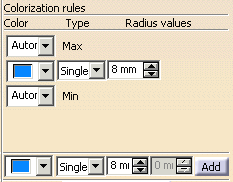
Note that:
-
The rules will be added in the order of sorting. So even if you change the radius value for the rule, it may get rearranged in the sorting order.
-
The rule can be deactivated by setting its color as Automatic.
-
All colorization rules and colors for other options are saved (only when you click OK to close the dialog box) and are restored when you launch the capability again.
Fillets
-
-
Repeat the previous operations for fillets, just choose a distinct color to identify them. Red, for example.
You must obtain this: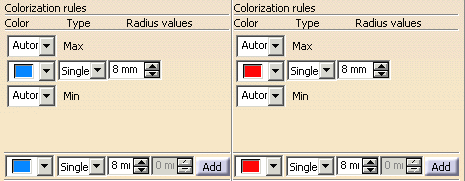
-
Set the yellow color as the background color. This means that all the faces of the selected body that do not follow any rule are colored in yellow.

-
Once done, click OK to compute the results.
An informative window appears, detailing the number and the composition of detected rounds and fillets.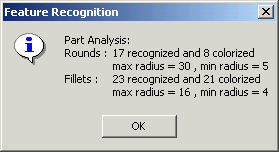
-
Click OK to close the informative window.
The result now appears. 8 rounds identified by the blue color and 5 fillets identified by the red color, which radius values are 8mm were recognized.
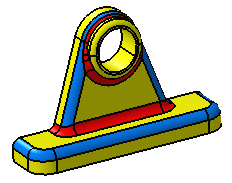
Detecting Fillets and Rounds by Specifying Ranges of Radius Values
-
Click the Part Analysis icon
 again.
again.
The Part Analysis dialog box appears. You can notice that the values and colors defined in the previous steps are still displayed in the dialog box.Rounds
-
To colorize rounds or fillets as per range of radius value, you need to add colorization rules of the range type: to do this, you just need to set the Range option.
The second radius field is then activated as shown below:
-
Similarly to defining single values, set a color for this rule and define the range of radius values in the two spinners available next to the Range field. Range type rule means, fillets/rounds within that range are colored with that rule. For example set the brown color and 5mm and 7mm as the values defining the range.
-
Click Add to validate the rule.
The dialog box must look like this: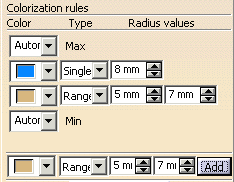
-
Once done, click OK to compute the results and close the dialog box.
Fillets
-
If you wish to define ranges of values for recognizing fillets, just repeat the same previous steps, paying attention to defining distinct colors.
Deleting Colorization Rules
As the rules can be added, the rules can be deleted too from the set of colorization rules. You can delete rules whenever you wish to. For this you, just need to right-click on the added rule to select the Delete rule contextual command that appears.
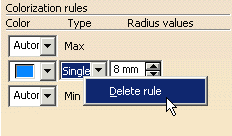
Notes About Defining Rules
While defining or editing the rules for rounds or fillets, the following three types of messages are given:
-
Message 1:
While defining or editing rules, if the base radius of 1 rule becomes same as that of ther rules, the following message is displayed:
"Part Analysis
This is invalid rule
Base radius for this rule conflicts with that of rule 3."
(Here, the current rule being modified has the same base radius as that of rule 3): -
Message 2:
While defining or editing rules, if the base radius of range type of rule is more than top radius of the range, the following message is displayed:
"Part Analysis
This is invalid rule
The first radius value cannot be greater than the second value."
(To avoid getting this message frequently, it is better to change the top radius value of the range) -
Message 3:
While defining or editing rules, if the range of one rule overlaps the range of another rule, then the following message is displayed:
"Part Analysis
This is invalid rule
Range of radius values of this rule conflicts with that of rule 3."
(Here the range of the current rule being modified overlaps with that of rule 3):
-